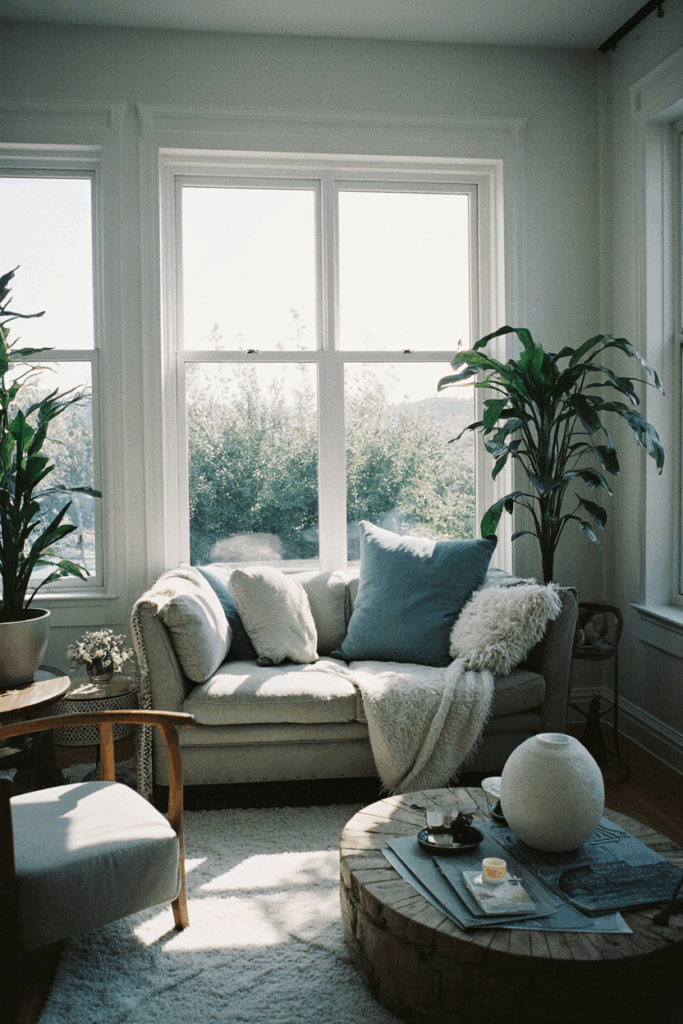The noise and pace of the outside world can be a great weight in our shoulders. At times like this, you want a place that you can shut the door on and that cleanses you of all this tumult, rests your spirit and taxes your batteries. This is not a luxury but a necessity of modern life. This is exactly where the idea of a “healing room” seems relevant. It’s more than making a pretty space; it’s a purposely created space to help you get in touch with yourself mentally, emotionally and spiritually.
I will not only tell you what to buy in this guide. Instead I will guide you step by step to design a healing environment that is sensually appealing to you, rooted in the fundamentals of psychology, and completely your own. Let’s do this together and turn a corner of your home in to an oasis for your soul to breathe.
Table of Contents
The Foundations of a Sanctuary: The Psychology of a Healing Space

Before we dive into decor choices, understanding the fundamental psychological elements that make a space “healing” will make every step we take more meaningful. [1]
Mental Simplicity: The “Less is More” Principle
The brain is always bombarded by incoming information from the environment. A messy, complicated space imposes what designers call “cognitive load” on our brains, even if we are not conscious of it. [2, 3] The first rule of a healing space is simplicity. To reduce is, in fact, to make more room in your head. You don’t have to be a minimalist, but everything in the space should serve a purpose and make you feel good. [4]
Emotional Design: The Power of Color and Light
Colors directly influence our moods. This is something called instinctive design; we see a color and our subconscious reacts. It took some time; there is certainly a lot to catch up with here. [1]
- Calming Tones: Nature-inspired colors like light blue, sage green, lavender, and earth tones (beige, cream, warm gray) soothe the nervous system and provide a sense of peace.
- Natural Light: Make use of natural light as much as possible. Sunlight improves our mood by increasing serotonin levels. Instead of heavy curtains, opt for light fabrics like sheer or linen that filter the light.
- Layered Lighting: In the evenings, use layered and warm lighting instead of harsh ceiling lights. A salt lamp, a dimmable table lamp, or candlelight can instantly create a more intimate and relaxing atmosphere. [5]
Healing with the Five Senses: Decoration Ideas

A true sanctuary should appeal to all five of our senses. This approach transforms the space from a place that is merely “seen” to a place that is “experienced.” [6]
1. Sense of Sight: Visual Calm
- A Touch of Nature (Biophilic Design): Adding live plants is one of the most effective ways to reduce stress and clean the air. You could begin with easy-to-care-for plants such as the snake plant, peace lily or mother-in-law’s tongue. Natural materials such as wood, bamboo, or stone convey a sense of grounding as well.
- Meaningful art: Cover your walls with images that inspire and calm you. It could be a landscape photograph, an abstract painting or a meaningful image you personally took. You want to create a point of focus that when you look at it, it makes you feel good.
- Hide the Mess: Invest in decorative lidded boxes and baskets so that your space doesn’t look as chaotic as your life sometimes feels. Eliminate any distracting visual excess.
2. Sense of Hearing: The Sound of Silence
- Soothing Noise: A white noise machine or small tabletop water fountain can help mitigate distracting outside noises and create a meditative atmosphere. Sounds of nature, like rain or ocean waves, work well, too.
- The power of music: Create a playlist of meditative or instrumental music for yourself.
- The Value of Silence: If possible support the space with elements that reduce sound insulation. Sound is absorbed by thick rugs, fabric wall panels, or a full bookshelf of books.
3. Sense of Smell: The Key to Memory and Peace
Olfaction is most associated with memory and affect. The right smell can instantly relax us.
Aromatherapy: Get an essential oil diffuser. Oils like lavender (calming), chamomile (relaxing), sandalwood (grounding), and bergamot (stress-reducing) are wonderful choices for your healing space.
Natural Scents: You can use candles or incense made from soy or beeswax with natural essential oils. Fresh flowers or a bundle of eucalyptus will also spread a fresh and natural scent in the room.
4. Sense of Touch: The Feeling of Comfort
Playing with different textures adds depth and warmth to the space.
- Soft Textiles: A plush rug on the floor, a soft wool blanket draped over your chair, or velvet pillows instantly create a feeling of comfort and invitation.
- Comfortable Seating: This could be a large beanbag, floor cushions, or a comfortable armchair reserved just for you. The goal is to create a corner where you can comfortably let your body relax.
- Natural Textures: A smooth river stone you can hold, a string of wooden beads, or other natural objects that are pleasant to touch enrich the sensory experience.
5. Sense of Taste: A Nourishing Break
This is an often neglected step but it can bring a big difference with a small touch.
- Tea Corner: Place a small tray in a corner of your space. On it, put your favorite herbal tea, a beautiful cup, and perhaps a pitcher of fresh mint or lemon water. This small ritual will make the time you set aside for yourself even more special.
“Designing a healing space is not about copying a magazine cover. It’s about listening to what your soul needs and responding to it in a visual, auditory, and tactile language. The most powerful design tool is empathy.”— Dr. Elara Vance, Interior Psychology Expert [7, 8]
My Healing Corner: A Personal Touch

At my home, although my room is not spacious, I’ve carved a small nook for myself beside the window. There is an ancient arm chair I have, my feet sit on a squishy rug, and I can always access a knitted blanket. The small side table holds one plant, a diffuser of lavender oil, and the book I am reading. Nothing else. That corner is where I leave my phone at the end of the day, sit with just a cup of chamomile tea, breathe, and listen to myself. The effect of even this small space on my mood is incredible.
Frequently Asked Questions
1. How can I create a healing space in a small room?
Simplicity is even more important in small spaces. Use light colors on the walls, choose more minimalist pieces instead of large, bulky furniture, and take advantage of vertical space with wall shelves. Mirrors can make the space feel larger and brighter. The key is to focus on creating a “corner” rather than the entire room. [11]
2. What are the best colors for a healing room?
Generally, calming colors found in nature are best. These include soft blues, greens, beiges, creams, and warm grays. The important thing is to choose a color palette that personally brings you peace. [1]
3. What can I do if I’m on a tight budget?
Creating a healing space doesn’t have to be expensive. You can start by simply decluttering and rearranging existing furniture. An interesting branch or stone collected from a nature walk, fresh flowers in a beautiful jar, a soft shawl found at a thrift store, or even a piece of art you made yourself can make a big difference.
Final Words: Your Journey Begins
Remember, creating a healing space is not a destination, but a continuous journey. It is a physical reflection of the care and love you show yourself. It doesn’t have to be perfect; it just has to be “yours.” Start with small steps. Maybe this week you just buy a plant or get rid of the clutter in your room. Most importantly, put your heart into the process of creating this space. Because the most beautiful decoration is the reflection of your own soul.

